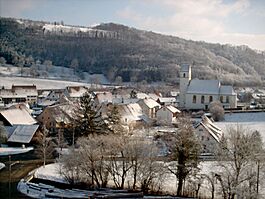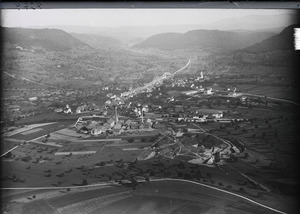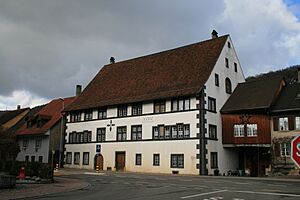Hornussen, Aargau facts for kids
Quick facts for kids
Hornussen
|
||
|---|---|---|
 |
||
|
||
| Country | Switzerland | |
| Canton | Aargau | |
| District | Laufenburg | |
| Area | ||
| • Total | 7.27 km2 (2.81 sq mi) | |
| Elevation | 382 m (1,253 ft) | |
| Population
(December 2006)
|
||
| • Total | 845 | |
| • Density | 116.23/km2 (301.0/sq mi) | |
| Postal code |
5075
|
|
| Surrounded by | Bözen, Elfingen, Frick, Ittenthal, Sulz, Ueken, Zeihen | |
Hornussen was once a small town, or municipality, in Switzerland. It was located in the Aargau area. On January 1, 2022, Hornussen joined with three other towns. These were Bözen, Effingen, and Elfingen. Together, they formed a new municipality called Böztal.
Contents
Hornussen's Past: A Look at History
Early Times and Roman Roads
People lived in the Hornussen area a very long time ago. This was during the Stone Age. Later, in the Roman era, an important road passed through here. This road went over a mountain called Bözberg.
The first time Hornussen was written about was in 1281. It was called Hornescon back then. For many years, a church group from Säckingen owned the land. They had special rights over the village.
Habsburg Rule and Special Status
Until 1797, Hornussen was part of the Austrian-Habsburg Empire. After 1803, it became part of the Canton of Aargau. From the 1400s, Hornussen had a special role. It was an important economic center. The local lord also handled legal appeals for the area.
You can still see old buildings from this time. The administration building from 1595 is one example. Other old houses are along the Bözbergstrasse. Because it was near a border, Hornussen avoided much war damage. This helped keep many old buildings safe.
Church and Pilgrimages
The church of St. Mauritius in Hornussen was important. The church in Säckingen chose its pastors. The current church building was built between 1710 and 1712. As early as 1600, people from Hornussen made a yearly trip. They went on a pilgrimage to Todtmoos in the Black Forest.
Economy and Changes Over Time
Besides farming, Hornussen was known for its inns and hotels. It was a stop for travelers crossing the Bözberg mountain. In the 1800s, people started making things from straw at home. Later, the area became known for its wine.
In 1875, Hornussen got a train line. This was the Bözbergbahn. Even with the train, many people moved away. They went to industrial areas or other countries. In 1917, a soap and cosmetics factory started here. Since 1996, a big highway, the A3 motorway, has reduced traffic in the village. By 2000, most people living in Hornussen traveled to other towns for work.
Hornussen's Landscape: Geography
Hornussen covers about 7.27 square kilometers (2.8 square miles). Almost half of this land, 49%, is used for farming. Forests cover about 40% of the area. Buildings and roads take up about 11% of the land. A small part, less than 1%, is rivers or lakes.
Most of the built-up area is homes and other buildings. Roads make up a smaller part. The forests are mostly dense woods. Some areas have orchards or small groups of trees. For farming, people grow crops. They also use land for pastures and fruit trees. All the water in the town comes from rivers and streams.
Hornussen is located in the upper Fricktal valley. The town grew around the church hill. It is a linear village, meaning it stretches out along a road.
Hornussen's Symbol: Coat of Arms
The coat of arms for Hornussen is red. It shows a silver plow blade pointing down. Above it, there are three red five-pointed stars on a silver stripe.
Who Lives in Hornussen: Demographics
Population and Languages
Hornussen has a population of about 845 people. About 13.4% of the people are from other countries. Over the last 10 years, the population has grown by about 13.8%. Most people in Hornussen speak German (91.3%). Italian is the second most common language (2.5%). Albanian is the third (1.8%).
Age Groups in the Community
In Hornussen, about 8.9% of the people are children under 10. Teenagers, aged 10 to 19, make up 12.5% of the population. Young adults, aged 20 to 29, are 13.4%. People between 30 and 59 make up a large part of the population. Older adults, aged 60 and above, are about 18% of the population.
Homes and Households
In Hornussen, about 63.6% of homes are owned by the people living in them. In 2000, there were 315 homes in the town. On average, about 2.6 people lived in each home. In 2008, there were 177 single-family homes. This was about 45.6% of all homes and apartments. Only a few apartments were empty, about 0.8%.
Education in Hornussen
Most adults in Hornussen have a good education. About 74.7% of people aged 25–64 have finished high school or gone on to higher education. In the 2008/2009 school year, 54 students attended primary school in Hornussen.
Population Changes Over Time
Here's how the population of Hornussen has changed over the years:
| Historical population | ||
|---|---|---|
| Year | Pop. | ±% |
| 1768 | 387 | — |
| 1850 | 766 | +97.9% |
| 1900 | 590 | −23.0% |
| 1950 | 631 | +6.9% |
| 2000 | 816 | +29.3% |
Important Buildings: Heritage Sites
The old Säckinger Amtshaus at Hauptstrasse 37 is a very important building. It is listed as a Swiss heritage site of national significance. This means it's a special historical place. The entire village of Hornussen is also recognized as an important heritage site.
How Hornussen Works: Economy
In 2005, there were 42 people working in farming. This is the primary sector. About 61 people worked in manufacturing and construction. This is the secondary sector. Another 68 people worked in services like shops and hotels. This is the tertiary sector.
Many people who live in Hornussen work outside the town. In 2000, about 83.3% of residents traveled to other places for work. However, 116 people came into Hornussen to work. About 18.8% of workers used public transportation. Most, 54.6%, used a private car to get to work.
Beliefs in Hornussen: Religion
Based on a 2000 survey, most people in Hornussen are Roman Catholic (54.5%). About 26.8% belong to the Swiss Reformed Church. A small number, about 0.49%, are Christian Catholic.
See also
 In Spanish: Hornussen para niños
In Spanish: Hornussen para niños







